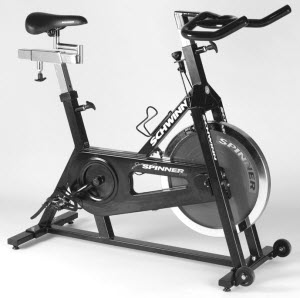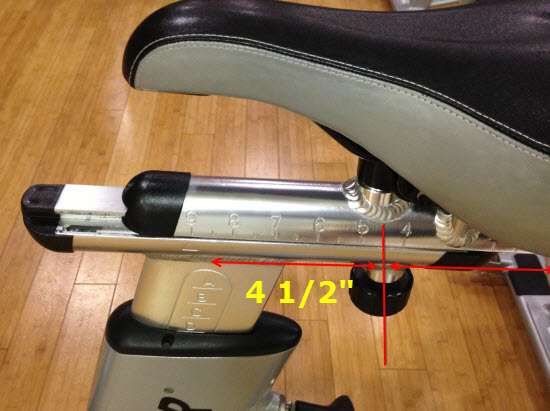
Is it fair to call this the "Model T" of Indoor Cycling?
Myth: Indoor Cycles require a lot of Fore/Aft Saddle adjustment to accommodate the range of cyclists coming into your class.
Real bicycles only provide about 2" of total saddle adjustment (through the saddle frame rails) to properly fit the owner with their knee over the pedal spindle... so why are many Indoor Cycles designed with up to 9" of adjustment like the Spinner® NXT?
To make the riders comfortable, even if they ended up in a horribly wrong position, that's why.
This Myth goes all the way back to the very first Johnny G Spinners. Remember those?
The whole Spinning® thing was brand new. We were encouraging people who probably hadn't been on a bike for 20 years, to climb on and ride for 45 minutes. Many most didn't have the flexibility to ride comfortably in the proper position and wanted to ride bolt upright. In those days the handlebars only moved up and down - not in and out. Raising the bars helped some, but moving the seat forward helped a lot!
So that's what riders did and God help you if you suggested otherwise 🙁
I'm guessing that Johnny knew exactly how to properly fit a rider to a bicycle. But I also believe that he and his early partners understood that if people aren't comfortable, they won't come back = end of the program.
Notice how the original Johnny G Spinners above appears to have far less travel than the NXT below that offers a whopping 9" (4 1/2" either way of center)?

I need to credit Schwinn for being the first manufacture (that I'm aware of) with the courage rein in the amount of saddle travel (in part by offering handlebars with Fore/Aft adjustment. The AC Performance is limited to about an 1" or so either way from center. The FreeMotion S11 series has a similar amount of travel because that's all they need 🙂
You can read the rest of my Myth series here.
- Happy 75th Birthday Ed Hayes! - April 24, 2024
- Eagles pedaling through the air metaphor - April 21, 2024
- ICI Podcast 238 Meet Nerd Fitness Creator Steve Kamb - April 6, 2024

Thanks, John. It’s great that bike fit is becoming a more refined process.
The further back you go in the history of … well, anything, the more primitive it gets. I’m reminded of an old saying, the origin of which I can no longer recall: “A mouse standing on the shoulders of an elephant can see a long way.” I find myself feeling like that mouse frequently.
Best,
Joan
Well… the difference between real bikes and an IC bikes is that real bikes come in many frame sizes/geometries. They don’t need much room for saddle fore/aft positioning because if you have the right size frame, you don’t need that much fore/aft movement to find the right fit. An IC bike is more “one size fits all”. Imagine if you had to climb onto a road bike belonging to someone 5 or 6 inches taller or shorter than you… You would certainly need more saddle adjustment to try and ride that bike than you would on a properly fitted frame. The only way to achieve an effective geometry mimicking what a rider’s road bike fit might be is to adjust what we can – saddle & handlebar height & saddle and handle bar fore-aft position. Some riders (me included) really DO need to move that saddle forward!
There is actually a fair amount of disagreement in the bike fit world over the significance of “knee over pedal spindle” as a way to fit riders… I would argue that it’s NOT the most important fit consideration (despite the fact that’s what all of our IC certifications would tell us).
The rider’s center of gravity should generally be positioned over the bottom bracket. Depending on the rider’s anatomy, that may put their knee over the pedal spindle, or may put it in front of or behind the pedal spindle. KOPS “works” in most instances because the average person’s anatomy happens to put their center of gravity more or less over the bottom bracket when their knee is in that particular position.
This video provides a good discussion of why KOPS is more of a “myth” than a reality: http://www.youtube.com/watch?v=lFQfuGibf0A
Like the presenter in this video, I have a freakishly long femur, and KOPS puts me too far behind the pedal stroke – which is why I usually need to slide the saddle on an IC bike as far forward as it can go.
Here is the article referenced in the video: http://sheldonbrown.com/kops.html
Food for thought!
Thanks for this Jennifer – Note: Your post didn’t display initially because I have to approve comments that include a link – thank the Spammers who make hundreds of attempts each day.
I have an answer to your comment about varying frame sizes but not time today. I’ll try to respond Saturday.
The video you talk about goes to my Myth #5 I’ll publish next week 🙂
Jennifer/Joan/John,
Good stuff that goes to one of my many hot buttons.
It is ironic to me that bike fit is an topic that most certifications spend a good amount of time on. Music on the other hand is an after thought. Yet in class we are often judged by our music rather than how well we look after our riders bodies by applying generally accepted bike fit procedures.
Moreover, for all the myth busting and bio-mechanical discussion of bike fit, most riders will ultimately settle on the position of their preference. No surprise there but perhaps more surprising – at least to me – this applies to those sitting on the lead bike as well. So my question; Is leading by example a myth?
We’ve all been teaching long enough to have had the following experience.
You arrive to teach your class, the other instructor is cleaning up and leaving. You get your music playing, talk to your incoming class and at some point start to set the bike up for you. The first thing that you notice is that the seat is all the way aft and you have to lower it for your 5′ 10″ height. The handle bars are as low as they can go.
The instructor you follow is all of 5′ 4″. I just scratch my head wondering, am I missing something?
I’ve also been chastised for taking too long to bike fit by instructors who’ve been in this business far longer than I. At first I was a bit put off but as I pondered such ministrations from far more experienced instructors my commons sense kicked in. They knew that for all the time I spent on bike fit, those that I fit would – over time – adjust to something that felt good for them.
Seeing riders in such odd positions is frustrating for me. When I make suggestions I’m often told, no, this is good FOR ME! Perhaps I just need to find a taller elephant.
I agree Chuck – most riders will find a position that works for them, and the human body generally does a pretty good job of adapting to whatever position they settle on. IMO the biggie to worry about in fitting riders is saddle height. Loo low and there’s too much knee strain, too high and they’re rocking back & forth & hyper-extending on the down stroke. IMO the rest is more comfort and personal preference – especially on a bike that goes nowhere! 😉